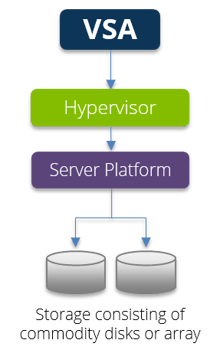 In today’s digital world, every facet of an organization must become elastic and more flexible, especially the IT department. The Virtual Server Appliance (VSA) can be one of the most valuable tools in your technology arsenal. No matter how much money you throw at hardware, it will never be as elastic as software. Instead, your business can employ VSA, where the storage controller runs in a single virtual machine, which manages the storage directly attached to its host. A VSA is not an appliance, rather, it’s software. Read on for a look into this solution.
In today’s digital world, every facet of an organization must become elastic and more flexible, especially the IT department. The Virtual Server Appliance (VSA) can be one of the most valuable tools in your technology arsenal. No matter how much money you throw at hardware, it will never be as elastic as software. Instead, your business can employ VSA, where the storage controller runs in a single virtual machine, which manages the storage directly attached to its host. A VSA is not an appliance, rather, it’s software. Read on for a look into this solution.
With the rising value of cloud computing, technology vendors are now offering VSA’s that can serve as a local gateway to off-premise cloud storage. Data is either stored or cached locally on the VSA residing in your data center, and then it will move data to the cloud. These storage managers regularly examine how often data is utilized throughout the company and distributes it accordingly. Data that is regularly accessed on a recurrent basis is stored locally while lesser used data is sent to the cloud for storage.
Since the VSA controller is purely software based, it can run on any type of storage component such as the classic, simple and affordable x86 platform. Whichever way you choose to implement it at your organization, the virtual storage appliance becomes a dedicated data store that can make use of all locally available unused storage for your virtual environment.
Leading Virtual Server Appliance Solutions
There are several great VSA solutions available today; here is an overview of the top two solutions which we believe demonstrate the clear advantages a VSA can offer.

- vSphere Storage Appliance: Although VMware currently only supports version 5.5 due to their VSAN solution, vSphere Storage Appliance offers customers a simple software storage appliance that can be bought as a single package or bundled with vSphere Essentials Plus. VMware promotes the five-click simplicity and allows you to install a VSA remotely through the hypervisor onto any ESXi host. Since it plugs straight into vSphere, VMware admins can take full advantage of features they have come to love such as vMotion, high availability, distributed resource scheduler and fault tolerance.
- Hewlett-Packard LeftHand Virtual SAN Appliance: Anyone who has worked with one of HP LeftHand SAN products should feel right at home interfacing with the HP LeftHand P4000 VSA. HP simply took the software from their LeftHand SAN products and packaged it to install on an x86 server platform, turning available storage into a LeftHand storage node. The P4000 VSA is designed to work with both VMware and Microsoft HyperV and can scale out as much as necessary.
While there are many virtual server appliance products on the market, they all work under the same philosophy; they leverage the power of a software-driven solution to provide organizations the ability to manage their storage with the level of agility and elasticity required in today’s constantly changing technology and business landscapes.
Elasticity and agility have become a mainstay necessity to thrive in today’s business environment. In essence, a VSA is leveraging the intelligence elasticity of software over vulnerable hardware. If hardware vulnerability sounds devaluating, think again. Some of the largest enterprises in the world (like Google) are running software intelligence over susceptible hardware. Even large data centers that insist on the robustness of an external intelligent disk array can utilize a VSA for data migrations between disparate storage platforms. They are also perfect for remote offices that don’t justify the cost of a traditional SAN.
Is your organization ready to implement the Virtual Server Appliance? Contact our experienced team today; we would be happy to assist you!










